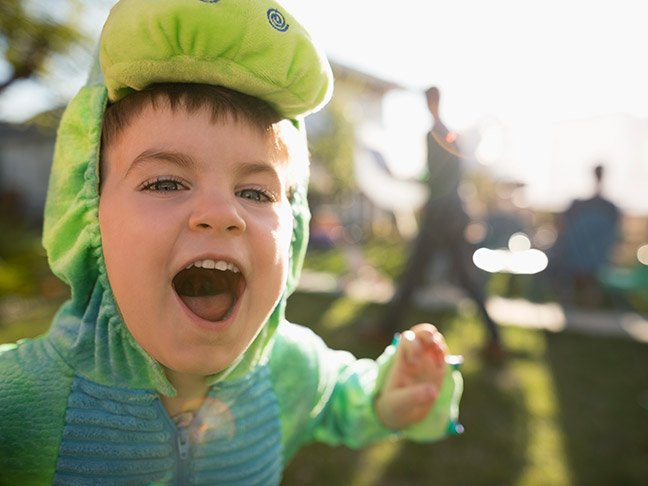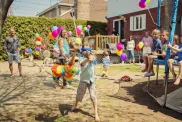Two was the year that my daughter started her “save the garden snail” campaign. Why the garden snails of the neighborhood repeatedly attempted to cross the sidewalk in the Southern California heat remains a mystery, but once she discovered their pattern, getting them to the other side to avoid bikes, feet, and untimely death became her life’s work. It was also the year of mismatched clothes, singing Beatles songs at the top of her lungs, and climbing absolutely everything. She wore a Belle dress for a solid three months during that year. She talked a lot, cracked jokes we didn’t always understand, and read books upside-down and backward. As parents, we’re warned a lot about the “terrible twos.” Two, as it turned out, was actually not that terrible. Don’t believe the hype.
It’s true that two is when tantrums begin to emerge for many, but in fairness to two-year-olds everywhere, it’s hard to know what to do with those big feelings when you have a limited vocabulary, and the word “no” is hurled in your direction a thousand times a day.
It should come as no surprise that this phase of development is marked by touching everything, getting into everything, and selective listening. Toddlers are curious little humans, and their best strategy for discovering and understanding is touching (eating is a close second) everything in sight. Manipulating their environments through their sense of touch is how they make sense of the world around them and gain new information. And if they only listen some of the time, well, that’s because they’re very busy.
Two is the year that toddlers begin to assert their wants (as in, “I only want to eat Goldfish crackers from now until eternity”), push boundaries, and find their voices. What people refer to as the “terrible twos” is also a period of rapidly shifting emotions. Two-year-olds experience enormous physical, social, and emotional growth, and all of that change is both exhausting and difficult to process. The result: power struggles and tantrums.
While parents are often cautioned that twos are positively “terrible”, they aren’t often told that twos can actually be quite terrific with the right tools in place. Yes, there will be tantrums at Target for no apparent reason, and sibling love won’t always be so obvious, but if we shift our thinking about this stage of development, we can see that positive moments outweigh the negative.
Try these strategies to transform the terrible twos to the terrific twos.
Rethink “terrible twos” tantrums
Any number of factors can contribute to tantrums associated with the so-called “terrible twos,” including the following:
- Overstimulation
- Exhaustion
- Changes in routine
- Hunger
- Frustration with limited communication
- Hearing “no” one too many times
- Big feelings
- Lack of independence
Unlike adults and big kids, toddlers aren’t developmentally capable of delayed gratification. When their needs aren’t met, they tend to blow. It’s their way of signaling their parents that they’ve had enough.
As much as toddlers are curious and adventurous, they do tend to be creatures of habit. I always encourage parents to keep a trigger tracker to figure out when and why tantrums are happening. When you understand the pattern, you can adjust accordingly.
Promote independence
Cute outfits on toddlers are great. Outfits created by toddlers are better. Two-year-olds know that they have their own preferences, but often well-meaning parents dismiss those preferences. Sure, kids need to dress a certain way for religious services, fancy parties, and other special events, but they don’t need to look like Gap models every day of the week.
Toddlers are desperate for independence, but they don’t have a lot of opportunities to practice independence skills. Let them choose their clothes and how they want their hair. Teach them to put on their own shoes. Invite them to help with cooking by washing fruits and vegetables and putting ingredients into a bowl. Ask them what they want to play instead of forcing “educational” toys in front of them.
Create a playful home
Speaking of play, toddlers need plenty of playtime and a playful environment to engage in this vital work of childhood. You don’t need to break the bank on tons of toys (in fact, when it comes to toddlers, less is more), but it does help to have a playful room that isn’t full of things that might break. The best way to avoid saying “no” on repeat is to get the valuables out of the way so your toddler can play independently.
While play can be messy, toddlers are more than capable of assisting with the cleanup. Think like a preschool teacher and get large bins that are easy for littles to fill with toys at the end of the day. Small brooms are also fun for helping out and toddlers can also wipe down tables after a day of messy art.
Stick to your routine
Two is not the year to skip naps, change eating habits, or stay up just a little bit later. Toddlers rely on routines because having structure takes the guesswork out of the day. They know what to expect and when to expect it. Visual charts that show how the day will unfold and what steps toddlers should take (get dressed, brush teeth, eat a snack) help toddlers internalize their routines.
Provide emotional support
Life can be overwhelming when you’re small. When those low moments happen, slow down and lean in with love and support. Toddlers don’t throw tantrums to upset their parents; they throw tantrums to communicate their very big feelings. When kids fall apart, they want to be hugged and cuddled. Connect instead of redirect to restore the emotional wellbeing of your toddler.
Photo: Getty








